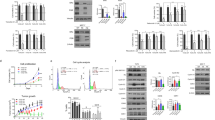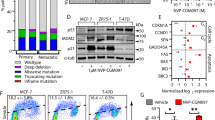Abstract
The rapamycin derivative RAD001 (everolimus) is presently in clinical trials. Preclinical studies have suggested preferential activity in antiestrogen resistant breast cancer cells. We investigated the response of breast cancer xenografts with different tamoxifen (TAM) sensitivity towards RAD001 and analyzed the regulatory machinery as well as the cross-talk between different signaling pathways. The ERα-positive and TAM-sensitive patient-derived breast carcinoma model 3366, its TAM-resistant counterpart 3366/TAM and 4049, a breast cancer with inherent TAM-resistance, were transplanted to immunodeficient nude mice and treated with RAD001 or TAM or the combination of both compounds. Shock frozen tumors were prepared for Western Blot and immunohistochemical analysis to semi-quantitatively evaluate the expression of the ERα and the ERα regulated IGF-IR as well as PTEN, pAkt, mTOR, (phospho)-p70S6K, (phospho)-4E-BP1 and cyclin D1. RAD001 significantly inhibited the growth of tamoxifen responding and non-responding xenografts. The highest efficacy was found for the combined treatment with TAM and RAD001. RAD001 modified the protein expression of mTOR and its downstream molecule 4E-BP1 as well as the level of PTEN and ERα, but independent of the tumors sensitivity towards TAM. The protein kinase Akt was found in the active phosphorylated form (pAkt) only in TAM-resistant xenografts, but not detectable in the TAM-responding 3366 line. All treatment modalities down-regulated pAkt expression in the TAM-resistant tumors. p70S6K and IGF-IR proteins were not significantly influenced by RAD001 treatment. Our findings document the linkage between different growth-controlling pathways. Due to its capability to be active in a TAM-resistant in vivo model, RAD001 could potentially serve as a promising second-line therapy in breast cancer.






Similar content being viewed by others
References
Vignot S, Faivre S, Aguirre D, Raymond E (2005) mTOR-targeted therapy of cancer with rapamycin derivatives. Ann Oncol 16:525–537
Dancey JE (2005) Inhibitors of the mammalian target of rapamycin. Expert Opin Investig Drugs 14:313–328
Chan S (2004) Targeting the mammalian target of rapamycin (mTOR): a new approach to treating cancer. Br J Cancer 91:1420–1424
Hay N (2005) The Akt-mTOR tango and its relevance to cancer. Cancer Cell 8:179–183
Sarbassov dos D, Ali SM, Sabatini DM (2005) Growing roles for the mTOR pathway. Curr Opin Cell Biol 17:596–603
Sun SY, Rosenberg LM, Wang X, Zhou Z, Yue P, Fu H, Khuri FR (2005) Activation of Akt and eIF4E survival pathways by rapamycin-mediated mammalian target of rapamycin inhibition. Cancer Res 65:7052–7058
Crowder RJ, Ellis MJ (2005) Treating breast cancer through novel inhibitors of the phosphatidylinositol 3´-kinase pathway. Breast Cancer Res 7:212–214
Carraway H, Hidalgo M (2004) New targets for therapy in breast cancer: mammalian target of rapamycin (mTOR) antagonists. Breast Cancer Res 6:219–224
Witton CJ (2004) Determining sensitivity to rapamycin and its analogues in breast cancer patients. Breast Cancer Res 7:41–42
Mita MM, Mita A, Rowinsky EK (2003) Mammalian target of rapamycin: a new molecular target for breast cancer. Clin Breast Cancer 4:126–137
deGraffenried LA, Friedrichs WE, Russell DH, Donzis EJ, Middleton AK, Silva JM, Roth RA, Hidalgo M (2004) Inhibition of mTOR activity restores tamoxifen response in breast cancer cells with aberrant akt activity. Clin Cancer Res 10:8059–8067
Mondesire WH, Jian W, Zhang H, Ensor J, Hung MC, Mills GB, Meric-Bernstam F (2004) Targeting mammalian target of rapamycin synergistically enhances chemotherapy-induced cytotoxicity in breast cancer cells. Clin Cancer Res 10:7031–7042
Naundorf H, Fichtner I, Büttner B, Frege J (1992) Establishment and characterization of a new human oestradiol- and progesterone-receptor-positive mammary carcinoma serially transplantable in nude mice. J Cancer Res Clin Oncol 119:35–40
Naundorf H, Becker M, Lykkesfeldt AE, Elbe B, Neumann C, Büttner B, Fichtner I (2000) Development and characterization of a tamoxifen-resistant breast carcinoma xenograft. Br J Cancer 82:1844–1850
Becker M, Sommer A, Krätzschmar JR, Seidel H, Pohlenz HD, Fichtner I (2005) Distinct gene expression patterns in a tamoxifen-sensitive human mammary carcinoma xenograft and its tamoxifen-resistant subline MaCa 3366/TAM. Mol Cancer Ther 4:151–168
Besada V, Diaz M, Becker M, Ramos Y, Castellanos-Serra L, Fichtner I (2006) Proteomics of xenografted human breast cancer indicates novel targets related to tamoxifen resistance. Proteomics 6:1038–1048
Naundorf H, Parczyl K, Zschiesche W, Reinecke S, Büttner B, Saul GJ, Sinn B, Fichtner I (1996) Relation of oestradiol-mediated growth stimulation with the expression of c-erbB-2 protein in xenotransplanted oestradiol-receptor-positive- and -negative breast carcinomas. J Cancer Res Clin Oncol 122:14–20
Hashemolhosseini S, Nagamine Y, Morley SJ, Desrivieres S, Mercep L, Ferrari S (1998) Rapamycin inhibition of the G1 to S transition is mediated by effects on cyclin D1 mRNA and protein stability. J Biol Chem 273:14424–14429
Law M, Forrester E, Chytil A, Corsino P, Green G, Davis B, Rowe T, Law B (2006) Rapamycin disrupts cyclin/cyclin-dependent kinase/p21/proliferating cell nuclear antigen complexes and cyclin D1 reverses rapamycin action by stabilizing these complexes. Cancer Res 66:1070–1080
Stambolic V, Suzuki A, de la Pompa JL, Brothers GM, Mirtsos C, Sasaki T, Ruland J, Penninger JM, Siderovski DP, Mak TW (1998) Negative regulation of PKB/Akt-dependent cell survival by the tumor suppressor PTEN. Cell 95:29–39
Testa JR, Tsichlis PN (2005) AKT signaling in normal and malignant cells. Oncogene 24:7391–7393
Campbell RA, Bhat-Nakshatri P, Patel NM, Constantinidou D, Ali S, Nakshatri H (2001) Phosphatidylinositol 3-kinase/AKT-mediated activation of estrogen receptor alpha: a new model for anti-estrogen resistance. J Biol Chem 276:9817–9824
Gibbons JJ, Discafani C, Peterson R, Hernandez R, Skotnicki J, Frost J (2000) Proc Am Assoc Cancer Res 40:301
Georgakis GV, Younes A (2006) From Rapa Nui to rapamycin: targeting PI3K/Akt/mTOR for cancer therapy. Exp Rev Anticancer Ther 6:131–140
Bjornsti MA, Houghton PJ (2004) The TOR pathway: a target for cancer therapy. Nat Rev Cancer 4:335–348
Guertin DA, Sabatini DM (2005) An expanding role for mTOR in cancer. Trends Mol Med 11:353–361
Shaw RJ, Bardeesy N, Manning BD, Lopez L, Kosmatka M, DePinho RA, Cantley, LC (2004) The LKB1 tumor suppressor negatively regulates mTOR signaling. Cancer Cell 6:91–99
Noh WC, Mondesire WH, Peng J, Jian W, Zhang H, Dong J, Mills GB, Hung MC, Meric-Bernstam F (2004). Determinants of rapamycin sensitivity in breast cancer cells. Clin Cancer Res 10:1013–1023
Grewe M, Gansauge F, Schmid RM, Adler G, Seufferlein T (1999) Regulation of cell growth and cyclin D1 expression by the constitutively active FRAP-p70s6K pathway in human pancreatic cancer cells. Cancer Res 59:3581–3587
Bose S, Chandran S, Mirocha JM, Bose N (2006) The Akt pathway in human breast cancer: a tissue-array-based analysis. Mod Pathol 19:238–345
Yu K, Toral-Bazar L, Discafani C, Zhang WG, Skotnicki J, Frost P, Gibbons JJ (2001) mTOR, a novel target in breast cancer: the effect of CCI-779, an mTOR inhibitor, in preclinical models of breast cancer. Endocr Relat Cancer 8:249–258
Kim RH, Mak TW (2006) Tumours and tremors: how PTEN regulation underlies both. Br J Cancer 94:620–624
Clark AS, West K, Streicher S, Dennis PA (2002) Constitutive and inducible Akt activity promotes resistance to chemotherapy, trastuzumab, or tamoxifen in breast cancer cells. Mol Cancer Ther 1:707–717
Kato S, Endoh H, Masuhiro Y, Kitamoto T, Uchiyama S, Sasaki H, Masushige S, Gotoh Y, Nishida E, Kawashima H, Metzger D, Chambon P (1995) Activation of the estrogen receptor through phosphorylation by mitogen-activated protein kinase. Science 270:1491–1494
Datta SR, Brunet A, Greenberg ME (1999) Cellular survival: a play in three Akts. Genes Dev 13:2905–2927
Kurokawa H, Arteaga CL (2003). ErbB (HER) receptors can abrogate antiestrogen action in human breast cancer by multiple signaling mechanisms. Clin Cancer Res 9:511–515
Nicholson RI, Staka C, Boyns F, Hutcheson IR, Gee JM (2004) Growth factor-driven mechanisms associated with resistance to estrogen deprivation in breast cancer: new opportunities for therapy. Endocr Relat Cancer 11:623–641
Stoica GE, Franke TF, Moroni M, Mueller S, Morgan E, Iann MC, Winder AD, Reiter R, Wellstein A, Martin MB, Stoica A (2003) Effect of estradiol on estrogen receptor-alpha gene expression and activity can be modulated by the ErbB2/PI 3-K/Akt pathway. Oncogene 22:7998–8011
Liu M, Howes A, Lesperance J, Stallcup WB, Hauser CA, Kadoya K, Oshima RG, Abraham RT (2005) Antitumor activity of rapamycin in a transgenic mouse model of ErbB2-dependent human breast cancer. Cancer Res 65:5325–5336
Frogne T, Jepsen JS, Larsen SS, Fog CK, Brockdorff BL, Lykkesfeldt AE (2005) Antiestrogen-resistant human breast cancer cells require activated protein kinase B/Akt for growth. Endocr Relat Cancer 12:599–614
Stewart AJ, Johnson MD, May FE, Westley BR (1990) Role of insulin-like growth factors and the type I insulin-like growth factor receptor in the estrogen-stimulated proliferation of human breast cancer cells. J Biol Chem 265:21172–21178
Wan X, Harkavy B, Shen N, Grohar P, Helman LJ (2006) Rapamycin induces feedback activation of Akt signaling through an IGF-1R-dependent mechanism. Oncogene 26:1932–1940
Akkiprik M, Nicorici D, Cogdell D, Jia YJ, Hategan A, Tabus I, Yli-Harja O, Yu D, Sahin A, Zhang W (2006). Dissection of signalling pathways in fourteen breast cancer cell lines using reverse-phase protein lysate microarray. Technol Cancer Res Treat 6:543–552
Torres-Arzayus MI, Yuan J, DellaGatta JL, Lane H, Kung AL, Brown M (2006) Targeting the AIB1 oncogene through mammalian target of rapamycin inhibition in the mammary gland. Cancer Res 66:11381–11388
Acknowledgements
We gratefully thank Monika Becker for excellent support concerning the animal experiments. Furthermore, we thank Heidi Lane from Novartis Pharma AG (Basel, Switzerland) for supply of RAD001 and for critical reviewing of the manuscript.
Author information
Authors and Affiliations
Corresponding author
Rights and permissions
About this article
Cite this article
Behrens, D., Lykkesfeldt, A.E. & Fichtner, I. The mTOR pathway inhibitor RAD001 (everolimus) is highly efficacious in tamoxifen-sensitive and -resistant breast cancer xenografts. Targ Oncol 2, 135–144 (2007). https://doi.org/10.1007/s11523-007-0054-5
Received:
Revised:
Accepted:
Published:
Issue Date:
DOI: https://doi.org/10.1007/s11523-007-0054-5




